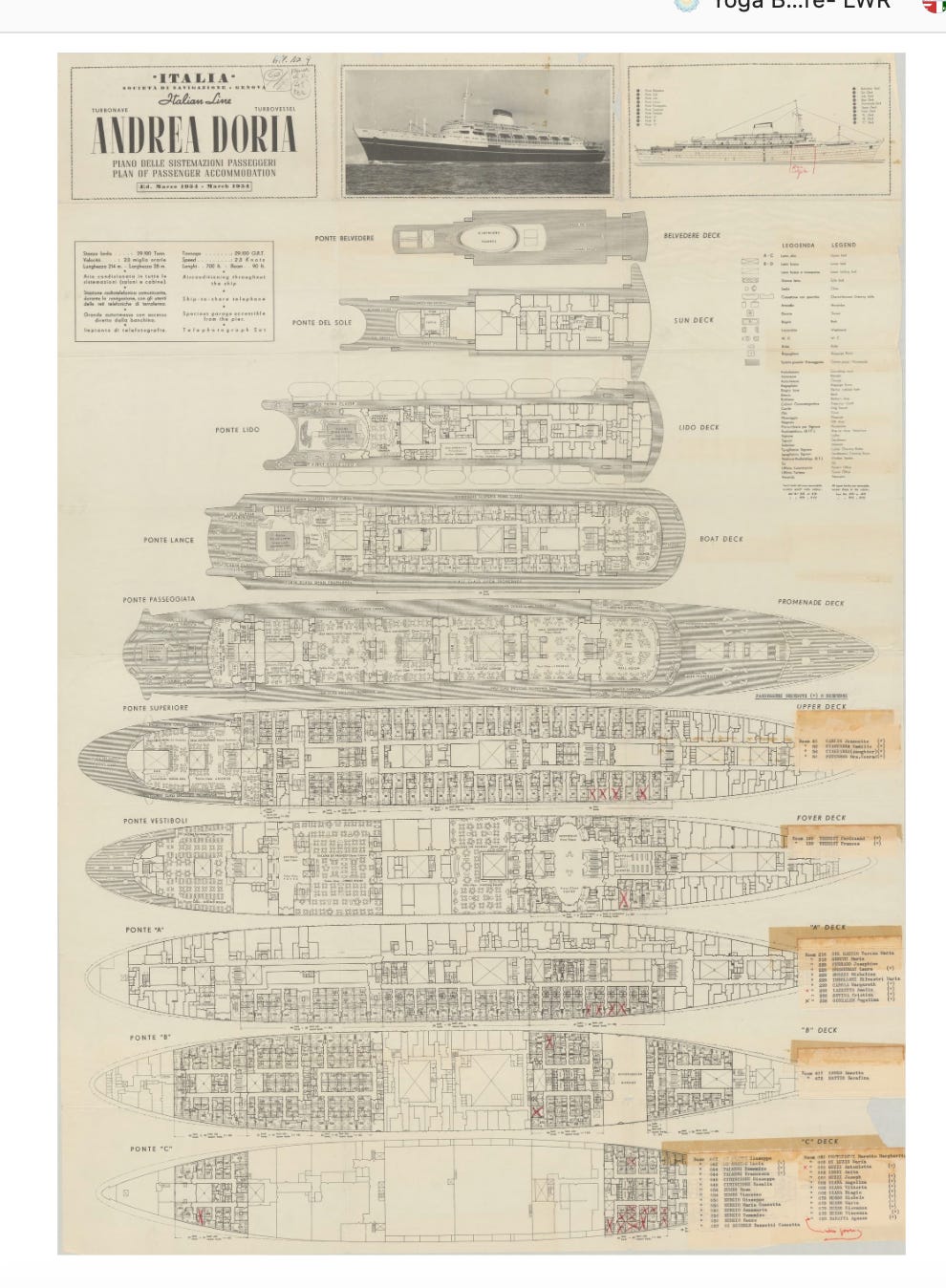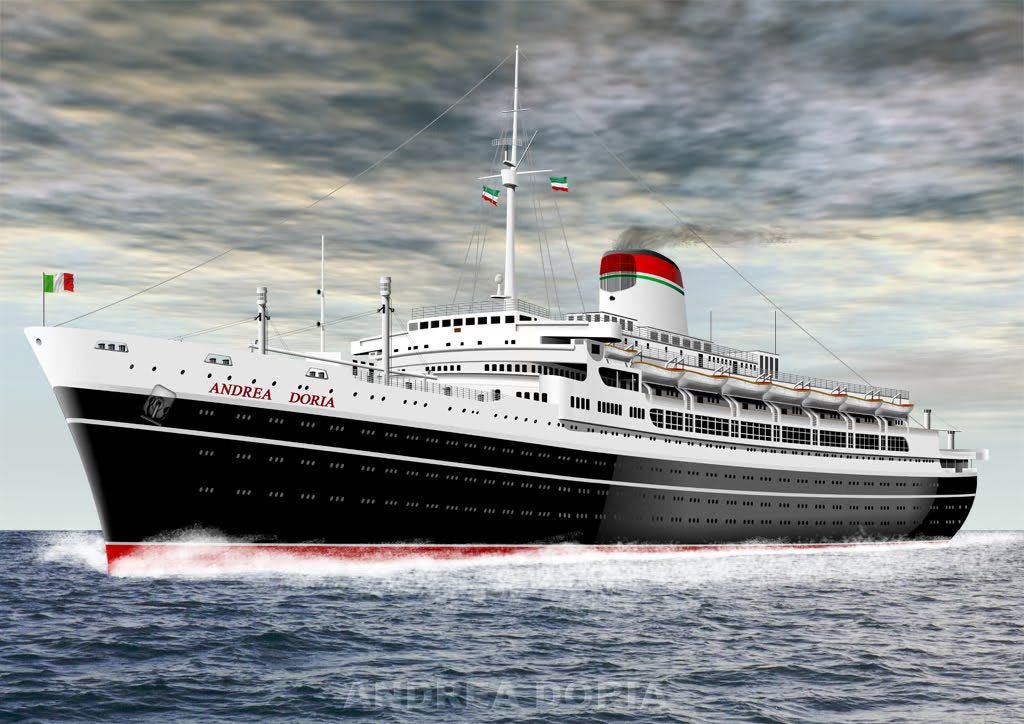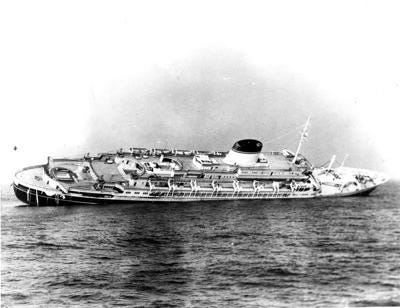Family History: A Tragic Account of Two Cousins Lost at Sea.
Port of Naples, Italy. July 18, 1956. They were coming to America to start a new life. Their lives were cut short when they boarded the Andrea Doria.
The following account was written as a result of a conversation I had with my 94-year-old mother approximately 4 years ago. We were discussing family history on a visit that took place prior to her passing at the age of 95. (Please read my post “Sicilian Family Memories and a Frittata” for some background on this conversation with my mom.) I was fascinated by the details of her life; growing up in a large family behind my grandfather’s barber shop with two Sicilian immigrant parents, an abusive father, living through the Great Depression and stories about my father who died at the young age of 35. She also told me about an incident involving my grandmother and some distant cousins on the Andrea Doria.
“Wait! We had cousins on the Andrea Doria?!”, I exclaimed.
It wasn’t until recently that I had the time to delve into the details of this tragic event. I wanted to write this account for two reasons. The first reason is to honor the memory of these two distant relatives and the second is to let the world know who they were.
The tragedy involved two cousins of mine who sailed on the doomed Andrea Doria from Naples, Italy to New York. A 29-year-old father traveling with his 2 year old daughter to a new life in America. I was able to verify some of my mother’s facts based on my own research however, aside from listening to actual interviews and reading transcripts of conversations of the actual survivors of this accident, little is known about my distant cousins who perished. Nothing is written about them as was written about some of the other passengers. Never a mention other than their names on the Tourist Class passenger manifest. The only tangible thing I have is a copy of a photo of my cousins that was left with my maternal grandmother’s final possessions and then passed on and ended up in my mother’s possessions. I vividly remember my mother showing me this picture one day as we were going through family photos long ago. She didn’t elaborate who these people were other than relatives of my grandmother. I will share with you what I know and what I was able to piece together by my research.
I would like to give you some background on this infamous state of the art passenger ship which sailed the Atlantic during a time when emigration to America by sea was nearing its end in popularity due to the advent of the jet age. More and more people, if they could afford it, were choosing to fly to America in mere hours over 7-9 days at sea.
For those unfamiliar with this tragedy, the Andrea Doria was a luxurious transatlantic ocean liner owned by the Italian Line. The ship was built with many state-of-the art technological advantages but despite these advantages, it was a well-known fact that the Andrea Doria had its flaws. Shipbuilding models discovered the ship would list if impacted by a major force such as a rogue wave or worse, such as an impact with another ship.
GENOA, JANUARY 14, 1952
The Andrea Doria’s inaugural sailing was scheduled on December 14, 1952. It was delayed due to mechanical issues and departed on its maiden voyage one month later on January 14, 1953. The departure from Genoa included stops in Cannes, Naples and Gibraltar before making its way across the Atlantic for an arrival in New York on January 23, 1953. The ship was renowned for its luxurious accommodations in all passenger cabins and was a favorite of the rich and famous. Over $1 million was spent on artwork and decor of the cabins and public rooms. All three classes of passenger accommodations including First Class, Cabin Class (2nd Class) and Tourist Class (3rd Class or Steerage Class) were equipped with luxuries unparalleled to any other ship of its day. Yes, even the less privileged emigrants traveling in Tourist Class had their own dining room, lounges and swimming pool. The ship would make its popular run from Genoa to New York for 4 1/2 years back and forth across the Atlantic before the fateful 51st voyage of the Andrea Doria which took place on July 17, 1956.
4 1/2 years later…..
GENOA, JULY 17, 1956
At 08:00 AM the Andrea Doria was loaded with provisions and supplies for the 9-day voyage across the Atlantic. Passenger embarkation was taking place with access onto the ship separated by cabin class. The classes were kept separate on board as much as possible but it was a well-known fact that the curious Cabin and Tourist Class passengers would often cross into the forbidden territory of First Class to take a peek at the “good life” and were usually chased back to where they belong by the ship’s crew.
The ship departed Genoa with 277 passengers and made her way to Cannes with an arrival the same day.
The Andrea Doria loaded 48 more passengers in Cannes and then departed for Naples at 18:00 that evening for the overnight sailing to Italy.
NAPLES, JULY 18, 1956
The Andrea Doria arrived in Naples early that morning and loaded an additional 744 passengers. The majority of passengers were emigrants from southern Italy and Sicily who like my grandparents before them in 1920, made their way to Naples to board a ship that would take them to a better life, better jobs and an opportunity to raise their families in America. Southern Italy was in terrible shape after WWII. It was still in bad shape in 1956 with little work to be found aside from farm work or picking oranges and olives. This was especially true in the small rural towns. The allied bombings in 1943 left Sicily in total devastation. Houses were leveled. Food and water were scarce. Production facilities were out of commission. Any infrastructure was decimated. More than 6,000 victims were killed during the bombing campaigns with over 70,000 wounded. My great-grandfather, his second wife and father-in-law were among the victims as a result of a bombing mission in Ribera, Sicily. It is from my great-grandfather’s side of the family that the story of Domenico Palmeri of Naples and his 2-year-old daughter Francesca Maria Palmeri begins to unfold. The Andrea Doria departed Naples on that warm summer day at 18:00 and set sail for Gibraltar with Domenico and Francesca Maria aboard.
The first question I had for my mother was “Where was Domenico’s wife and why was he traveling alone with his daughter?” Reasonable question. My mother replied that his wife went ahead of him to America and was already living and working in Pennsylvania. Domenico was traveling with his daughter and carrying all their savings in cash in order to buy a house once he got to America. That is as much as I know about Domenico and Francesca Maria.
GIBRALTAR, JULY 20, 1956
The Andrea Doria makes a stop off the coast of Gibraltar to pick up 65 passengers who were tendered to the waiting ship. The ship departed for its voyage across the Atlantic shortly after boarding was completed.
NEW YORK CITY, JULY 25, 1956
The passenger liner Stockholm of the Swedish American Line departs New York City at 12:00 headed for its home port of Gothenburg, Sweden. The Stockholm departed with 534 passengers and a crew of 208. Though this ship was not as opulent as the Andrea Doria, it was a popular choice among passengers headed to Scandinavia. That day, it was decided by the crew that the Stockholm would sail north of its intended course across the Atlantic in order to save time rather than the original southern shipping lanes used for eastbound traffic. This move not only put the ship in more fog prone areas off the coast of New England but it also put the Stockholm right in the middle of the popular west bound shipping lanes used by passenger ships heading to New York.
As the Andrea Doria crept through the waters off the coast of Nantucket, she made her way slowly through patches of dense fog. The ship’s fog horns had been sounding as a precaution for hours however there was no cause for alarm as the ship would be arriving in New York on schedule the next day. Passengers were told that evening to start preparing for disembarkation in New York. Passengers joined each other for the last time at a variety of the ship’s eating and drinking venues and said their good-byes to new acquaintances and friends. Others went to their cabins to pack their belongings and went to bed early in order to get a good night’s sleep before the big day ahead of them.
As the Andria Doria gingerly made its way west towards New York through the dark of night and dense fog, the Stockholm was also making its way east that night. Through their radar systems, each ship knew the approximate location of each other however neither ship realized that they were on a collision course. Oddly, although the two ships knew the proximity of each other, no attempt was made by either ship to contact each other through verbal communication. Both ships were unaware of just how close to each other they actually were until they sighted each other a few moments before impact. Although the Andrea Doria made a last-minute attempt at desperately turning the ship south to its left, its maneuver was too late. At approximately 23:10 that evening, the Stockholm T-boned the Andrea Doria on its forward starboard side. The Stockholm thrust its bow 40 feet into the hull of the Andrea Doria. The Stockholm lost 30 feet of its bow in the collision. Thousands of gallons of seawater entered the Andrea Doria flooding everything in its path. The actual point of impact was where the forward Tourist Class cabins were located. The precise location on Deck C where Domenico and Francesca Maria were sleeping in their beds in Stateroom #644.




Whether or not Domenico and Francesca Maria ever knew what hit them will never be known. One can only imagine the horrifying chain of events that took place upon impact. They were either killed by the impact or drowned, fell into the shark infested waters of the Atlantic or are still entombed in the wreckage at the bottom of the sea off the coast of Nantucket. Their life savings for their new life in America went with them. Forty-six lives were lost on the Andrea Doria as well as 5 crew members from the Stockholm that night. All others were rescued by nearby rescue ships including the ships’ captains. As was previously predicted, within hours of the impact the Andrea Doria began to list on its starboard side and sunk into the Atlantic shortly after 10:00 AM the next day on July 26, 1953.
NEW YORK CITY- July 26, 1956
My mother’s story continued with my grandmother leaving home in Brooklyn, New York on the morning of July 26 and heading to the pier in New York City to meet the arrival of the Andrea Doria with her cousin and his young child on board. A celebration was planned once they arrived back at the house. My grandmother had no idea what had happened the night before. As she arrived at the pier, she found enormous crowds and pandemonium everywhere. It was there that my grandmother was made aware of the accident. Remembering my grandmother, I can only imagine her reaction as she prayed that her relatives were still alive and faced with the harsh reality that she must inform Domenico’s wife about the accident. Information on survivors was not yet available as all of the passengers who were rescued from their lifeboats were placed on different passenger ships bound for New York. They had to be accounted for before those who were lost were made public. The harsh reality was her cousin and his daughter were gone and never to be recovered.
I cannot imagine the phone call that took place once my grandmother was faced with reality. She had to place that call to Domenico’s wife. How did she explain the loss of her husband and daughter? It must have been horrifying.
I was just a young child when the sinking of the Andrea Doria occurred. I never met Domenico. Even if I did, at the age of three years old it would be impossible for me to remember him. However, he and Francesca Maria live in my thoughts as I imagine what it must have been like at the moment of impact. I am haunted by the vision of the gushing waters swirling through the cabin as he scrambled to grab his daughter and was swallowed by the sea.
The Andrea Doria still rests on the floor of the Atlantic. Its remains are deteriorating as diver expeditions video the decay for all to see. Many divers have died themselves braving the depths of the Atlantic while trying to capture the remains of the once glorius ship. In my opinion, those who dive to the site to collect the scattered plates, cutlery and other service and personal items from the sunken ship as souvenirs are desecrating a grave. Let it be. Let them rest. If Domenico and Francesca Maria are down there together, let them rest in peace. I will certainly not forget them or their final voyage on the Andrea Doria.

There are numerous videos and documentaries on YouTube if you would like to learn more about the Andrea Doria tragedy. There is also a website at www.andreadoria.org that is maintained by a member of the organization that contains all kinds of information, photos, passenger lists and other information you may find interesting regarding the history of the Andrea Doria.
Pippo









Wow, I don't think I'd ever heard this story before. I'm glad you wrote it.
As a reader, my favorite thing about this is the way you blended documented history with personal family stories. I've been thinking about this all day - well done!!!